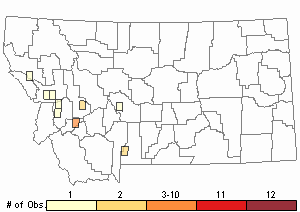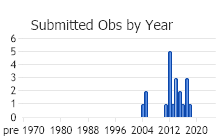View in other NatureServe Network Field Guides
NatureServe
Montana
Utah
Wyoming
Idaho
Wisconsin
British Columbia
South Carolina
Yukon
California
New York
A Diatom - Cymbella janischii
General Description
Morphological Category - Asymmetric biraphid.
Size RangeLength 13-360 µm.
Width 35–68 µm.
Striae in 10 µm 6-8.
Type locality: San Francisco, California, USA
Useful Link:
Diatom Glossary [Diatoms of North America website]
Diagnostic Characteristics
Range Comments
Cymbella janischii is found in the Cascade, Northern Rockies, Sierra Mountain Ranges of the northwestern United States, where it is considered to be a regional endemic.
Cymbella janischii is common in streams draining the Cascades and eastern slopes of the Sierra Nevada Mountains. This diatom is particularly abundant in the Bitterroot and Clark Fork Rivers in western Montana but appears to be absent from the upper Snake River system and the Flathead and Kootenai River drainages. East of the Continental Divide it is common in the Gallatin River, a tributary of the Missouri River, but uncommon in the Madison River, which drains geothermal features in Yellowstone National Park. Cymbella janischii is absent from the upper Yellowstone River, which also drains geothermal features in the Park, but common in a Yellowstone tributary, the Boulder River, which does not drain geothermal features.
Observations in Montana Natural Heritage Program Database
Number of Observations: 20
(Click on the following maps and charts to see full sized version)
Map Help and Descriptions
Relative Density

Recency



 (Observations spanning multiple months or years are excluded from time charts)
(Observations spanning multiple months or years are excluded from time charts)
Habitat
Found in rivers and creeks.
Ecology
Category: endemic, indicator
WATER CHEMISTRY
pH = 7.1; C = 58 µS/cm; T = 12.0 °C (AWM)
Reproductive Characteristics
Diatoms typically reproduce by cell division (mitosis) and occasionally by meiosis—sexual reproduction in which female and male gametes combine to form a specialized zygote called an auxospore. Repeated divisions result in cells of a population becoming progressively smaller and smaller. When cells reach a critically small size, sexual reproduction is initiated, resulting in an auxospore and initial cells that are the largest attainable for the species, after which cell division and size reduction resume (Amato 2010).
Management
Generally considered to be an indicator of higher water quality (Bahls 2007).
Stewardship Responsibility
References
- Literature Cited AboveLegend:
 View Online Publication
View Online Publication Amato, A. 2010. Diatom reproductive biology: living in a crystal cage. The International Journal of Plant Reproductive Biology 2(1): 1-10.
Amato, A. 2010. Diatom reproductive biology: living in a crystal cage. The International Journal of Plant Reproductive Biology 2(1): 1-10. Bahls, L.L. 2007. Cymbella janischii—Giant endemic diatom of the Pacific Northwest: morphology, ecology and distribution compared to Cymbella mexicana. Northwest Science 81(4):284–292.
Bahls, L.L. 2007. Cymbella janischii—Giant endemic diatom of the Pacific Northwest: morphology, ecology and distribution compared to Cymbella mexicana. Northwest Science 81(4):284–292. Kociolek, P. 2011. Cymbella janischii. In Diatoms of North America. Accessed January 27, 2018. https://diatoms.org/species/cymbella_janischii
Kociolek, P. 2011. Cymbella janischii. In Diatoms of North America. Accessed January 27, 2018. https://diatoms.org/species/cymbella_janischii
- Web Search Engines for Articles on "A Diatom"





